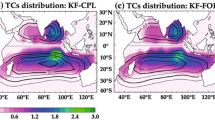Abstract
Tropical cyclone heat potential (TCHP) in the ocean can affect tropical cyclone intensity and intensification. In this paper, TCHP change under global warming is presented based on 35 models from CMIP5 (Coupled Model Intercomparison Project, Phase 5). As the upper ocean warms up, the TCHP of the global ocean is projected to increase by 140.6% in the 21st century under the RCP4.5 (+4.5 W m-2 Representative Concentration Pathway) scenario. The increase is particularly significant in the western Pacific, northwestern Indian and western tropical Atlantic oceans. The increase of TCHP results from the ocean temperature warming above the depth of the 26°C isotherm (D26), the deepening of D26, and the horizontal area expansion of SST above 26°C. Their contributions are 69.4%, 22.5% and 8.1%, respectively. Further, a suite of numerical experiments with an Ocean General Circulation Model (OGCM) is conducted to investigate the relative importance of wind stress and buoyancy forcing to the TCHP change under global warming. Results show that sea surface warming is the dominant forcing for the TCHP change, while wind stress and sea surface salinity change are secondary.
Similar content being viewed by others
References
Collins, M., and Coauthors, 2013: Long-term climate change: projections, commitments and irreversibility,1029-1136. Climate Change 2013: The Physical Science Basis. Contribution of Working Group I to the Fifth Assessment Report of the Intergovernmental Panel on Climate Change, T. F. Stocker, et al., Eds., Cambridge University Press, Cambridge, United Kingdom and New York, NY, USA.
Domingues, C. M., J. A. Church, N. J. White, P. J. Gleckler, S. E. Wijffels, P. M. Barker, and J. R. Dunn, 2008: Improved estimates of upper-ocean warming and multi-decadal sea-level rise. Nature, 453, 1090–1093.
Emanuel, K. A., 2001: The contribution of tropical cyclones to meridional heat transport by the oceans. J. Geophys. Res., 106(D14), 14771–14781.
Goni, G., and Coauthors, 2009: Applications of satellite-derived ocean measurements to tropical cyclone intensity forecasting. Oceanography, 22, 190–197.
Gray, W. M., 1979: Hurricanes: Their formation, structure, and likely role in the tropical circulation. Meteorology over the Tropical Oceans, D. B. Shaw, Eds., James Glaisher House, 155–218.
Huang, P., I.-I. Lin, C. Chou, and R. H. Huang, 2015: Change in ocean subsurface environment to suppress tropical cyclone intensification under global warming. Nature Communications, 6, 7188, doi: 10.1038/ncomms8188.
Ishii, M., and M. Kimoto, 2009: Reevaluation of historical ocean heat content variations with time-varying XBT and MBT depth bias corrections. Journal Oceanography, 65, 287–299.
Knutson, T. R., and Coauthors, 2013: Dynamical downscaling projections of twenty-first-century Atlantic hurricane activity: CMIP3 and CMIP5 model-based scenarios. J. Climate, 26, 6591–6617.
Large, W. G., and S. Yeager, 2009: The global climatology of an interannually varying air-sea flux data set. Climate Dyn., 33, 341–364, doi: 10.1007/s00382-008-0441-3.
Leipper, D. F., and L. D. Volgenau, 1972: Hurricane heat potential of the Gulf of Mexico. J. Phys. Oceanogr., 2, 218–224.
Levitus, S., and Coauthors, 2012: World ocean heat content and thermosteric sea level change (0–2000 m) 1955–2010. Geophys. Res. Lett., 39, L10603.
Lin, I.-I., C.-C. Wu, I.-F. Pun, and D.-S. Ko, 2008: Upperocean thermal structure and the western North Pacific category 5 typhoons. Part I: Ocean features and the category 5 typhoons’ intensification. Mon. Wea. Rev., 136, 3288–3306, doi: 10.1175/2008MWR2277.1.
Locarnini, R. A., and Coauthors, 2013: World Ocean Atlas 2013, Vol. 1: Temperature. S. Levitus, Ed., A. Mishonov Technical Ed.; NOAA Atlas NESDIS 73, 40 pp.
Madec, G., 2008: NEMO ocean engine. Note du Pôle de modélisation, Institut Pierre-Simon Laplace (IPSL), France, No 27, ISSN No 1288-1619.
Mei, W., F. Primeau, J. C. McWillams, and C. Pasquero, 2013: Sea surface height evidence for long-term warming effects of tropical cyclones on the ocean. Proceedings of the National Academy of Sciences of the United States of America, 110(38), 15207–15210.
Mei, W., S. P. Xie, F. Primeau, J. C. McWilliams, and C. Pasquero, 2015: Northwestern Pacific typhoon intensity controlled by changes in ocean temperatures. Science Advances, 1, e1500014.
Palmer, M. D., K. Haines, S. F. B. Tett, and T. J. Ansell, 2007: Isolating the signal of ocean global warming. Geophys. Res. Lett., 34, L23610.
Pun, I.-F., I.-I. Lin, and M.-H. Lo, 2013: Recent increase in high tropical cyclone heat potential area in the Western North Pacific Ocean. Geophys. Res. Lett., 40, 4680–4884, doi: 10.1002/grl.50548.
Shay, L. K., G. J. Goni, and P. G. Black, 2000: Effects of a warm oceanic feature on hurricane Opal. Mon.Wea. Rev., 128, 1366–1383.
Sobel, A. H., and S. J. Camargo, 2011: Projected future seasonal changes in tropical summer climate. J. Climate, 24, 473–487, doi: 10.1175/2010JCLI3748.1.
Sriver, R. L., and M. Huber, 2007: Observational evidence for an ocean heat pump induced by tropical cyclones. Nature, 447, 577–580.
Taylor, K. E., R. J. Stouffer, and G. A. Meehl, 2012: An overview of CMIP5 and the experiment design. Bull. Amer. Meteor. Soc., 93, 485–498.
Wada, A., and N. Usui, 2007: Importance of tropical cyclone heat potential for tropical cyclone intensity and intensification in the western North Pacific. Journal of Oceanography, 63, 427–447, doi: 10.1007/s10872-007-0039-0.
Wada, A., and J. C. L. Chan, 2008: Relationship between typhoon activity and upper ocean heat content. Geophys. Res. Lett., 35, L17603, doi: 10.1029/2008GL035129.
Wada, A., N. Usui, and K. Sato, 2012: Relationship of maximum tropical cyclone intensity to sea surface temperature and tropical cyclone heat potential in the North Pacific Ocean. J. Geophys. Res., 117, D11118, doi: 10.1029/2012JD017583.
Wang, C. Z., L. P. Zhang, S.-K. Lee, L. X. Wu, and C. R. Mechoso, 2014: A global perspective on CMIP5 climate model biases. Nature Climate Change, 4, 201–205, doi: 10.1038/nclimate2118.
Author information
Authors and Affiliations
Corresponding author
Rights and permissions
About this article
Cite this article
Liu, R., Chen, C. & Wang, G. Change of tropical cyclone heat potential in response to global warming. Adv. Atmos. Sci. 33, 504–510 (2016). https://doi.org/10.1007/s00376-015-5112-9
Received:
Revised:
Accepted:
Published:
Issue Date:
DOI: https://doi.org/10.1007/s00376-015-5112-9




